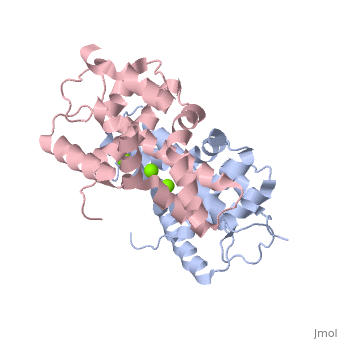Dicer
From Proteopedia
(Difference between revisions)
| (12 intermediate revisions not shown.) | |||
| Line 1: | Line 1: | ||
| - | + | <StructureSection load='2EB1' size='350' side='right' caption='Human Endoribonuclease Dicer C-terminal complex with Mg+2 ion (green) (PDB code [[2eb1]])' scene=''> | |
| - | <StructureSection load=' | + | |
==Introduction== | ==Introduction== | ||
| - | + | '''Dicer''', or '''endoribonuclease Dicer''', was discovered/named in 2001 by Emily Bernstein. She was a graduate student in Greg Hannon's lab at the Cold Spring Harbor Laboratory in New York. She was trying to discover the enzyme that was responsible for removing small RNA fragments from double-stranded RNA. The dicer enzyme was found by isolating it from the RISC complex in the RNAi mechanism. It was known that RISC was not responsible for chopping up these small RNA fragments, so this complex was isolated from the system to locate the enzyme that was the source for these RNA fragments.<ref>PMID: 11201747</ref> | |
| - | + | ||
| - | + | ||
| - | + | ||
| - | + | ||
| - | + | ||
| - | + | ||
Dicer is a type of [[Ribonuclease]] that processes potentially harmful double-stranded RNA (dsRNA) into microRNA and small-interfering RNA (siRNA) to be used in the process of RNA interference. Dicer is commonly utilized by cells in order to prevent the assimilation of viral DNA into the cells’ genome. The viral DNA is butchered into smaller segments that are each about 21 nucleotides long; the cut take places at the 5’ phosphate and the 3’ hydroxyl, and usually includes a 2 nucleotide overhang. There is a single processing center in HS Dicer implying that there are two catalytic sites which help form products with the 2 3' overhang. These newly formed segments attach themselves to single stranded mRNA which ultimately leads to mRNA degradation by the cell and translational suppression. The dicer enzyme in humans contains three domains: the <scene name='70/706244/Rnase_iii_1/1'>RNase III 1</scene>, <scene name='70/706244/Rnase_iii_2/1'>RNase III 2</scene>, and the <scene name='70/706244/Paz_domain/1'>Paz Domain</scene>.<ref name=jmol>PMID: 16410517</ref> There are three classes of RNase III proteins which are divided into categories called Escherichia coli RNase III, <scene name='70/706244/Drosha/1'>Drosha</scene>, and Dicer which are given the numbers one, two, and three respectively. The Escherichia coli RNase III class has one domain while the Drosha and dicer have two domains each. There is no evidence of the first class of enzymes in mammals.<ref name=biochem>PMID: 17920623</ref> | Dicer is a type of [[Ribonuclease]] that processes potentially harmful double-stranded RNA (dsRNA) into microRNA and small-interfering RNA (siRNA) to be used in the process of RNA interference. Dicer is commonly utilized by cells in order to prevent the assimilation of viral DNA into the cells’ genome. The viral DNA is butchered into smaller segments that are each about 21 nucleotides long; the cut take places at the 5’ phosphate and the 3’ hydroxyl, and usually includes a 2 nucleotide overhang. There is a single processing center in HS Dicer implying that there are two catalytic sites which help form products with the 2 3' overhang. These newly formed segments attach themselves to single stranded mRNA which ultimately leads to mRNA degradation by the cell and translational suppression. The dicer enzyme in humans contains three domains: the <scene name='70/706244/Rnase_iii_1/1'>RNase III 1</scene>, <scene name='70/706244/Rnase_iii_2/1'>RNase III 2</scene>, and the <scene name='70/706244/Paz_domain/1'>Paz Domain</scene>.<ref name=jmol>PMID: 16410517</ref> There are three classes of RNase III proteins which are divided into categories called Escherichia coli RNase III, <scene name='70/706244/Drosha/1'>Drosha</scene>, and Dicer which are given the numbers one, two, and three respectively. The Escherichia coli RNase III class has one domain while the Drosha and dicer have two domains each. There is no evidence of the first class of enzymes in mammals.<ref name=biochem>PMID: 17920623</ref> | ||
| Line 29: | Line 22: | ||
Dicer is known to be a direct cause of macular degeneration. The absence of Dicer in retinal pigment epithelium causes the eye to break down into macular degeneration. It is hypothesized that Dicer has a specific role in maintaining this retinal health.<ref>PMID: 19836333</ref> | Dicer is known to be a direct cause of macular degeneration. The absence of Dicer in retinal pigment epithelium causes the eye to break down into macular degeneration. It is hypothesized that Dicer has a specific role in maintaining this retinal health.<ref>PMID: 19836333</ref> | ||
| + | |||
| + | For 3D structures of dicer See [[Ribonuclease 3D structures]] | ||
== References == | == References == | ||
<references/> | <references/> | ||
| + | [[Category:Topic Page]] | ||
Current revision
| |||||||||||
Proteopedia Page Contributors and Editors (what is this?)
Justin Woodard, Sam Hayes, Michal Harel, Ann Taylor, Wally Novak, Alexander Berchansky

